#web developer training
Explore tagged Tumblr posts
Text
Web Development Journey 2024: A Complete Roadmap
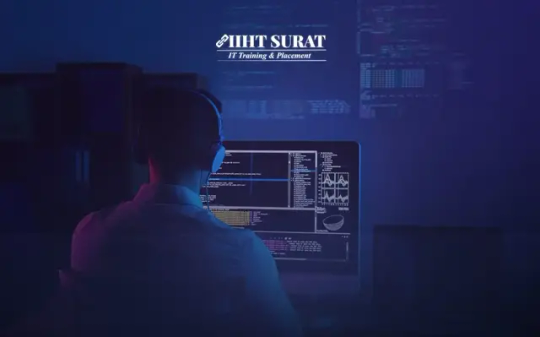
Get Started: Start by learning the fundamentals of web development. That entails familiarising yourself with JavaScript, HTML, and CSS. HTML establishes the framework, CSS adds style, and JavaScript adds the fun interactive elements.
Check Out the Options: Web development has its flavors, like frontend, backend, and full-stack. User interface is all that frontend is about, backend is the magic that works in the background, and full-stack? It embodies the best aspects of both worlds.
Skill Up: Time to level up your coding game. Learn the languages and tools that match your vibe. If you're into frontend, get cozy with React, Angular, or Vue.js. Backend more your thing? Think Python, Ruby, or PHP, and toss in some Django or Flask.
Get Your Hands Dirty: Build actual projects to put your skills to the test. Begin with a simple project, such as creating a fun app or your own website, and gradually increase the complexity. Show off your creations to impress potential bosses or clients.
Stay in the Loop: Web dev's always changing, so keep your finger on the pulse. Engage in online communities, attend webinars, read blogs, and follow experts on Twitter. It resembles belonging to a private group, and in social media posts.
Make Connections: Networking's not just for suits and ties. Join online hangouts like GitHub or Stack Overflow to meet fellow devs, swap ideas, and maybe even team up on projects. Hit up local meetups or conferences too – you never know who you'll meet.
Keep Learning: Whether it's online courses, bootcamps, or workshops, keep adding tools to your belt. These programs give you hands-on experience, projects to sink your teeth into, and chances to learn from the pros.
Get Some Experience: Internships, freelancing gigs, or volunteering – they all count. Internships give you a taste of the real world, freelancing pads out your portfolio, and volunteering feels good while you're at it. Look around online or ask your pals for leads.
Stay Chill, Stay Strong: Web dev's a rollercoaster ride. You'll hit roadblocks, face rejections, and wonder why you're doing this at 3 am. But stay cool, keep pushing, and remember – every setback is just a setup for a killer comeback. You got this!
Read More: A Comprehensive Plan To Become A Web Developer In 2024
#webdeveloper guide#web development#web developers#web design#front end developer#website developer course#web developer training
0 notes
Text

Web design is not just about creating preety layouts . It's about understanding the marketing challenge behind your business. Digital design is like painting, except the paint never deries. What are you waiting for? If you also want in-depth knowledge and want to upgrade yourself in the skill of your choice. Contact the phone number below immediately and make yours shine. Don't miss out - enroll now for the upcoming batch!
https://www.systemskills.in/
0 notes
Text
Can you become a pro web developer in a year?
https://nerdclips.com/can-you-become-a-pro-web-developer-in-a-year/
Can you become a pro web developer in a year?

#web developer bootcamp#web developer freelancer#web developer training#web develper course#Education#Stefan Mischook
0 notes
Text
I'm a Web developer
Hello, my name is Bettina and i'm 27 years old. I live in Sweden 🇸🇪 but i'm born in Hungary 🇭🇺.
I'm currently studying web development focusing e-commerce. I've done it for a year now and i have one year left in school. I have not had my internship yet.
The languages i'm learning:
HTML
CSS
JavaScript, React.js, Node.js, expess.js,
MySQL, PHP.
I've even experience UX-design, web design, digital marketing, SEO and entrepreneurship. And i love talking about problem solving and accessibility 🪄🪲
Currently i'm developing wordpress with PHP, HTML and hierarchical CSS.
So, if you are into this stuff, especially wordpress and php, talk nerdy stuff with me! I would be so happy if i had more connections with people who are into this stuff, especially women. 🌸
My github:
My portfolio:
It is not done yet, i will update it soon 🫣🐢
🌦️ A weather app made in our Javascript course:
#web developer#webdeveloer#web developers#website#web design#web development#tiikiboo#frontenddevelopment#frontend#backend#php#phpdevelopment#php developers#php programming#php training#html css#javascript#reactjs#wordpress ecommerce#wordpress#wordpress php#wordpress development#portfolio#developer#juinor#women in tech#tech#codeblr#code#programming
35 notes
·
View notes
Text

03.july23,mon ; internship
i had my first work-day today at my internship and my brain started melting alreadyyy D: i knew they were using PHP for their websites so i started off with learning HTML and CSS so far. Why does PHP seem so complicated compared to those two?:,)
I also didn't understand the connection between PHP and MySQL yet? can someone explain?
i decided to use my free night to begin the codecademy tutorial about PHP and just do that until i fall asleep, hopefully it will open my eyes a bit more than the website they provided me with. wish me luck(pls)<3
#codeblr#programming#coding#html#html css#htmlandcss#htmlcoding#studyblr#100 days of code#codecademy#php#php training#phpwebsitedevelopment#php web application development#phpmyadmin#mysql#webdevelopment#website#web developers#phpdevelopment#learn to code#code job#internship#skull internship
37 notes
·
View notes
Text
#seo#semo#digital marketing#course#training#web#web development#web design#zoho#zoho crm#AL#artificial intelligence#coaching computer class
2 notes
·
View notes
Text
Expertise in Digital Marketing, Web Dev, AI, Design & ZOHO Development - CSI Knowledge Hub
Discover cutting-edge digital marketing, web development, AI, web design, and ZOHO development services at CSI Knowledge Hub
2 notes
·
View notes
Text
Full Stack Developer vs. Front End Developer vs. Back End Developer
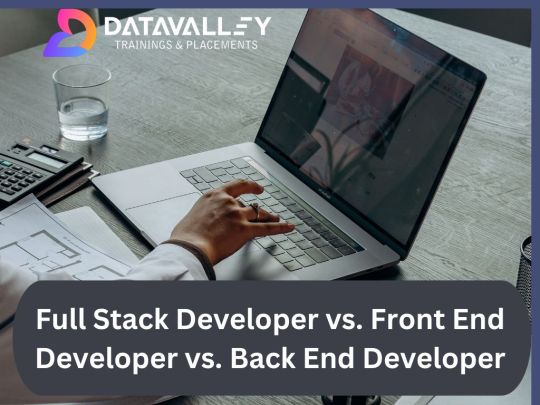
The role of a web developer is always included in the lists of high-paying IT jobs. This is because web developers are essential in today’s digital world. They create amazing websites, high-performing e-commerce sites, and other web-based applications. If you want to be a web developer, you must understand that full-stack developer skills are in great demand. However, do you understand the differences between full-stack, front-end, and back-end web development? In this post, we’ll see the differences between these three job roles, skills, and salaries.
What is Web Development?
The process of developing a website on the internet is known as web development. The non-design components of a website, such as building features and functioning with programming, markup, and scripting languages, are referred to as web development. Developers focus on technical aspects of website development such as architecture, programming, and application integration, as well as visuals.
A web developer is someone who does the following:
Creates and maintains webpages and other web-based applications.
Creates a website from a web design.
They collaborate with clients, stakeholders, and designers to understand the concept.
Can focus on frontend or backend development. Even as a full-stack developer, if necessary.
Types of Web Development
Front End Development: This aspect of web development focuses on what the user interacts with directly, i.e., the user interface of a website or web application. Front-end development deals with the design, layout, and interactivity of a site, ensuring that it’s visually appealing and user-friendly.
Back End Development: The back end is the part of a website or application that operates behind the scenes. It manages data, user authentication, and the server-side logic, ensuring the smooth functioning of the website.
Now, let’s delve into each of these roles in detail.
What is front-end development?
Front-end development, often referred to as client-side development, is the process of creating the visual elements of a website or web application that users interact with directly. It involves writing code for the user interface, optimizing website performance, and ensuring the site looks and functions correctly on various devices and browsers.
Who is a front-end developer?
A front-end developer, also known as a client-side developer, is responsible for turning web designs into a functioning website or application. They work closely with web designers and back-end developers to create an engaging and responsive user experience.
What are the front-end developer’s skills?
Front-end developers should be proficient in the following skills:
Mastery of HTML (Hypertext Markup Language) and CSS (Cascading Style Sheets) is fundamental for structuring and styling web pages.
Proficiency in JavaScript is crucial for adding interactivity and dynamic features to a website.
Knowledge of front-end frameworks like React, Angular, or Vue.js, which simplify and expedite development.
The ability to create websites that look and function well on various devices and screen sizes.
Ensuring that the website performs consistently across different browsers.
Familiarity with version control systems like Git for code management and collaboration.
Front End Developer Salary
The salary of a front-end developer can vary based on factors such as experience, location, and the company. On average, junior front-end developers can earn between $50,000 and $70,000 annually, while senior front-end developers can command salaries ranging from $90,000 to $120,000 or more.
What is Back End Development?
Back-end development, often referred to as server-side development, focuses on the server and database sides of a website or web application. It involves building and maintaining the server, databases, and applications that enable the front end to function correctly.
Who is a Back End Developer?
A back-end developer is responsible for managing the server, databases, and server-side logic of a website or application. They ensure that data is stored securely, accessed efficiently, and transmitted effectively between the front end and back end.
What are Back End Developer Skills?
Back-end developers should have expertise in the following areas:
Server-Side Programming Languages: Proficiency in languages such as Python, Ruby, Node.js, PHP, or Java is used to build server-side applications.
Databases: Knowledge of database management systems like MySQL, PostgreSQL, MongoDB, and NoSQL databases.
APIs: The ability to create and manage APIs (Application Programming Interfaces) for communication between the front end and back end.
Server Management: Skills in managing web servers and server infrastructure.
Security: Understanding web security practices and techniques to protect user data.
Version Control/Git: Proficiency in version control systems to manage and collaborate on code.
Back End Developer Salary
Back-end developer salaries can also vary based on experience, location, and the organization. Junior back-end developers can earn an annual salary ranging from $60,000 to $90,000, while senior back-end developers can expect salaries ranging from $100,000 to $150,000 or more.
Frontend vs. Backend Development
Front-end and back-end development are two halves of a whole, and they must work together seamlessly to create a functional website or application. While front-end developers focus on user interface and design, back-end developers deal with the underlying server infrastructure and data management. Both roles are essential for a successful web project.
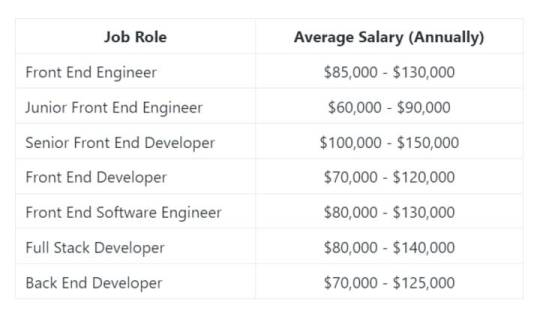
What is a Full Stack Developer?
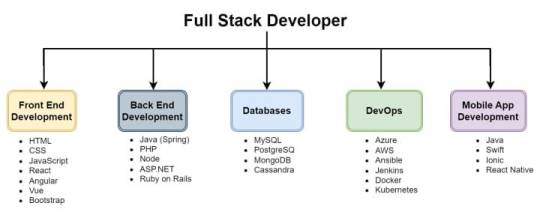
Who is a Full Stack Developer?
A full stack developer is a well-rounded professional who can take care of every aspect of web development, from designing the user interface to managing databases and server-side logic. They bridge the gap between front end and back-end development, ensuring that the entire application functions cohesively.
What are the Full Stack Developer Skills?
Full stack developers need a broad range of skills, including:
HTML/CSS: Proficiency in front end technologies for web page structuring and styling.
JavaScript: Mastery of JavaScript for creating dynamic and interactive web elements.
Front End Frameworks: Knowledge of front-end frameworks for efficient development.
Server-Side Programming Languages: Expertise in languages like Node.js, Python, Ruby, or Java for server-side development.
Databases: Proficiency in database management systems for data storage and retrieval.
APIs: Ability to create and manage APIs for communication between the front end and back end.
Version Control/Git: Familiarity with version control systems for code management.
Problem-Solving: Strong analytical and problem-solving skills to troubleshoot and optimize web applications.
Full Stack Developer Salary
Full-stack web developers are in high demand due to their range of skills and extensive knowledge. An average full stack developer’s annual salary might range from $110,000 to $150,000, based on their skill set and expertise.
Full-stack engineers earn more money than front end or back end developers. Employers agree to pay more for a full stack developer since it makes more business sense to hire one person with front and back end expertise rather than two.
As a result, the profession of a full stack developer is a profitable alternative for aspirants looking to create a career in the digital business.
The choice between becoming a full stack developer, front end developer, or back end developer depends on your interests, strengths, and career goals. Front end developers excel at creating visually appealing and user-friendly interfaces; back end developers focus on the server-side and data management; and full stack developers possess a comprehensive skill set that allows them to manage the entire development process. Each role is integral to the web development ecosystem, and the right one for you depends on your passions and aspirations within the field.
If you’re considering the path of a full stack developer and are eager to acquire the comprehensive skill set required to excel in this role, we have an excellent suggestion for you. Consider enrolling in the Full Stack Developer course at Datavalley.
Datavalley has a stellar track record of empowering aspiring developers with the knowledge and expertise to succeed in the dynamic world of web development. Their course covers everything from the fundamentals of HTML and CSS to in-depth training in JavaScript, front end and back end frameworks, and much more.
By joining Datavalley’s Full Stack Developer course, you’ll gain hands-on experience, build an impressive portfolio, and be well-prepared for a rewarding career in web development.
Don’t miss out on this opportunity to kickstart your journey as a Full Stack Developer with Datavalley. Your future in web development awaits. Take the first step today!
Attend Free Bootcamp at Datavalley
If you’re looking to supercharge your Java development skills and become a full-stack Java developer, consider joining the Java Full Stack Developer bootcamp at Datavalley. It’s an excellent opportunity to enhance your expertise and take your career to the next level.
Key points about Bootcamps:
It is completely free, and there is no obligation to complete the entire course.
20 hours total, two hours daily for two weeks.
Gain hands-on experience with tools and projects.
Explore and decide if the field or career is right for you.
Complete a mini project.
Earn a certificate to show on your profile.
No commitment is required after bootcamp.
Take another bootcamp if you are unsure about your track.
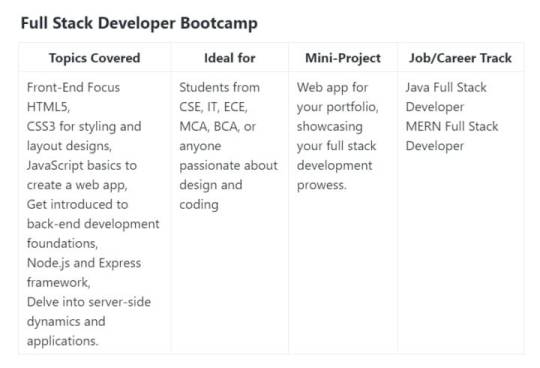
#datavalley#dataexperts#data engineering#data analytics#dataexcellence#business intelligence#data science#power bi#data analytics course#data science course#full stack course#full stack training#full stack web development#full stack developer#full stack software developer#front end developers#back end development
7 notes
·
View notes
Text
Success Roadmap: Comprehensive Web Developer Guide for 2024

In 2024, are you thinking about a career as a web developer? Great! You can get support from the "Success Roadmap: Comprehensive Web Developer Guide for 2024". Start with the basics: JavaScript, HTML, and CSS. They resemble web development's ABCs.
To learn them quickly, make the most of tutorials and internet resources. once attaining basic skills, improve the level of your skills. namic websites easy. The guide breaks down these advanced topics into simple steps. But here's the key: practice what you learn.
Build your projects to showcase your skills. Your portfolio is like your online resume, making you stand out. Networking is crucial too. Join online communities, attend events, and connect with pros. This opens doors to advice, collaborations, and job opportunities.
Stay updated with the guide. It keeps you in the loop with the latest trends and tech. Being on top of things will make you a top-notch web developer in 2024 and beyond. In a nutshell, the "Success Roadmap" is your easy-to-follow guide. It gives you clear steps, practical tips, and lots of resources to succeed in web development. Let's make 2024 your year of success!
Click here To know more: Web Developer Comprehensive Guide
#web developers#webdeveloper guide#web developer training#webdevelopment guidance#web deveopmentcourses
0 notes
Text
Learn Web Development in Mohali - Comprehensive Training Courses
Unlock your web development potential with The Skill Boost's comprehensive training courses in Mohali. Offering expert-led programs in cutting-edge technologies, this premier institute empowers aspiring developers with the skills and knowledge needed to excel in the dynamic world of Web Development. Experience hands-on learning, industry-relevant curriculum, and personalized mentorship for a transformative career journey.
2 notes
·
View notes
Text
Can you become a pro web developer in a year?
https://nerdclips.com/can-you-become-a-pro-web-developer-in-a-year/
Can you become a pro web developer in a year?

#web developer bootcamp#web developer freelancer#web developer training#web develper course#Education#Stefan Mischook
0 notes
Text
#code#full s#full stack course#full stack training#full stack web development#full stack developer#course#training#curse in pune
2 notes
·
View notes
Text

Journey of Digital Marketing!
The world of marketing has undergone a dramatic shift! In 1981, the first banner ad marked the dawn of digital marketing. Today, this dynamic field encompasses everything from engaging social media campaigns to strategic search engine optimization (SEO).
Are you interested in leveraging the power of the digital world for marketing success? Digital marketing courses in varanasi can equip you with the necessary skills to grow in this ever-evolving landscape. These courses cater to a wide range of individuals, from students seeking career paths to professionals looking to upskill or even homemakers seeking a career change.
Digital marketing courses typically offer a well-rounded curriculum, focusing on various areas like social media engagement strategies, mastering the art of SEO, and understanding the challenges of online marketing. These courses often go beyond just theoretical knowledge and often combine learning with practical exercises, internships, and even competitive opportunities. This complete strategy aims to prepare you for a successful career in the exciting world of digital marketing.
Explore further at https://digitalcrave.in/training/
#digital marketing#seo#web development#seo services#best digital marketing company#best digital marketing agency#digitalmarketingagency#wordpress#ecommerce#digital marketing course in varanasi#digital marketing training in varanasi
2 notes
·
View notes
Text
How to Set Freelancing Rates That Win You Clients

As a freelance writer, I've struggled with the best strategy to set rates for my services.
When I started freelancing, I priced myself too low out of fear of losing potential clients. While I could win some customers, I found myself struggling to pay bills. Underpricing services hurt my income, attracting clients unwilling to pay for quality work.
It took me years to realize the damage I was doing to myself and my business. I refined my pricing strategy to reflect the value I provide. When pitching projects, I show my expertise and value, aiming to deliver quality work.
With this strategy, I command higher rates and attract clients who value my work.
Quoting higher rates is always intimidating. I've found that clients willing to pay for quality are the most rewarding to work with.
I want to explore pricing strategies to attract and keep high-value clients. When pricing services, let the rates reflect the value you provide.
Pricing of Freelance Services
Setting the right freelance rates is a challenge for many freelancers. On one hand, you want to remain competitive and attract potential clients.
But, you also need to ensure that the rates compensate you for your time, skills, and expertise. Balancing between these factors is vital if you want to win clients while earning a fair income.
Freelance rates vary depending on the niche, experience, location, and specific services offered. Yet, there are key principles and strategies for effective pricing of services.
Understand the Value of Your Service
The foundation of setting the right price is understanding the value you bring. When you venture into freelancing, you provide value for customers. You must understand the value of your service.
Here are some aspects to help you understand the worth of your service.
Skills and Expertise: Assess your skills, experience, and expertise in the chosen field. Determine how your qualifications and experience compare to other freelancers.
Market Demand: Research the demand for your services in the market. Are there many clients seeking freelancers with your skills? Are there a few freelancers offering similar services?
Industry Standards: Check what other freelancers in the niche charge for similar services. This gives you a baseline to work from when setting your rates. You should be within the range of industry standards.
Cost of Living: Many freelancers disregard this aspect. The fact is, you need money to pay bills, invest, and grow your financial status. Consider the cost of living in your location. Freelancers in expensive cities must charge higher rates to cover their expenses.
Value Proposition: Identify the unique value proposition you offer to clients. You should differentiate yourself from other freelancers. What sets you apart from other freelancers? How does your expertise benefit your clients?
Pricing Strategies for Freelancers
Once you understand the worth of your services, you price services based on value and market. Here are some common pricing strategies I have used in my freelancing career.
Hourly Rates: Charging hourly rates is a straightforward pricing method. You invoice clients based on the number of hours worked. This is beneficial for projects where the scope and duration are uncertain.
Project-Based Pricing: The pricing approach sets a fixed rate for the entire project. Regardless of the hours it takes to complete, you will receive a standard rate. It is helpful for clients who prefer to know the total cost upfront.
Value-Based Pricing: The price is set based on the value provided instead of time spent. The approach captures the perceived value of services, earning higher rates.
Retainer Agreements: Retainer agreements charge clients a fixed monthly fee for ongoing services. This provides a steady income for freelancers and fosters long-term client relationships.
Extra Tips on Pricing Your Services
When you start freelancing, you might think that lower rates win customers. The truth is, there are clients repelled by cheap freelancers. Check the standard rates in your niche. Use this as a basis for establishing yourself as a premium service provider.
Your pricing should reflect the value you provide, not the time it takes to complete a task. Never fear to charge what you're worth. Clients who value your expertise will be willing to pay for it.
When setting your rates, consider the long-term impact on your business. Pricing too low attracts low-quality clients and undermines your credibility.
Setting Freelance Rates to Win Customers
Winning clients requires an understanding of your worth and implementing good pricing strategies. You should also communicate your service value.
Take time to assess your skills, do market research, and develop a pricing strategy. This will attract clients who appreciate your expertise and are willing to pay for it.
Remember, pricing isn't about covering your expenses. It's a compensation for the value you offer.
Never settle for low-hanging fruits. Target high-value customers who will make you proud of your work.
#article writing#freelancing websites#freelance copywriter#freelance#freelance digital marketing#freelance jobs#freelance life#freelance artist#freelance editor#freelance graphic designer#freelance seo specialist#freelance services#freelance web developer#freelance work#freelance writing#freelancers#freelancing#freelancing jobs#freelancing tips#freelancing training#freelancingguide
2 notes
·
View notes
Text
The Profound Benefits of Embracing Full Stack Development
Introduction: In the dynamic realm of software development, full stack developers have emerged as indispensable assets, equipped with the skills to navigate both front-end and back-end technologies seamlessly. This comprehensive exploration sheds light on the multifaceted advantages of embracing full stack development, unveiling the unique benefits and opportunities that accompany proficiency in both facets of the development stack.
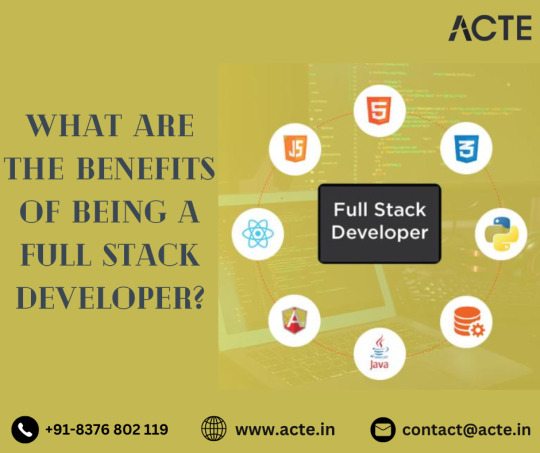
Unlocking the Benefits of Full Stack Development:
Versatility and Adaptability: Full stack developers possess a diverse skill set, encompassing proficiency in both front-end and back-end technologies. This versatility enables them to fluidly transition between different aspects of development, adeptly adapting to project requirements and challenges.Mastery of client-side and server-side technologies empowers full stack developers to tackle a myriad of tasks, from crafting intuitive user interfaces to implementing complex business logic. This adaptability renders them invaluable assets to development teams, capable of contributing to various stages of the software development lifecycle with finesse.
Comprehensive Project Ownership: A defining advantage of full stack developers lies in their ability to assume end-to-end ownership of projects, from inception to deployment. With a comprehensive understanding of both front-end and back-end technologies, full stack developers can oversee all facets of development, ensuring seamless integration and coherence throughout the project lifecycle.This holistic perspective empowers full stack developers to make informed decisions at every juncture of development, from conceptualization and architecture to execution and optimization. By embracing responsibility for the entire project, full stack developers drive efficiency, consistency, and quality, culminating in successful project outcomes.
Expanded Employability and Career Prospects: Full stack developers are highly coveted by employers owing to their diverse skill set and capacity to work across multiple technologies. Proficiency in both front-end and back-end technologies opens the door to a plethora of career opportunities across various industries and sectors.Employers prize full stack developers for their adaptability, versatility, and ability to deliver end-to-end solutions that align with business objectives. Whether it entails developing web applications, mobile apps, or enterprise software, full stack developers are poised to excel in diverse roles and environments, making them sought-after candidates in the job market.
Efficient Collaboration and Communication: Full stack developers excel in cross-functional collaboration, proficiently communicating with designers, product managers, and fellow developers alike. Their grasp of both front-end and back-end technologies bridges the gap between different teams and departments, fostering smoother communication and collaboration.This collaborative prowess enables full stack developers to seamlessly integrate with cross-functional teams, ensuring that project requirements are comprehended, feedback is incorporated, and deliverables are met punctually and within budget constraints. By fostering a culture of collaboration and synergy, full stack developers contribute significantly to project success and organizational growth.
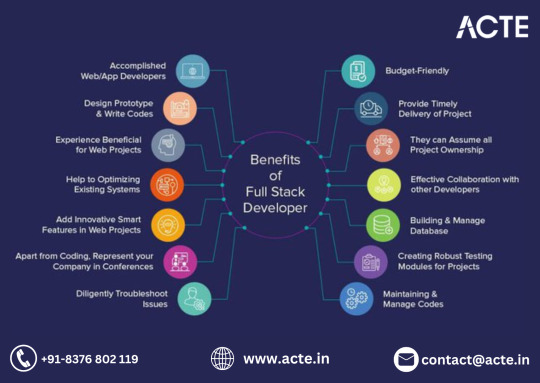
Agile Prototyping and Iteration: Full stack developers possess a knack for rapid prototyping and iteration, leveraging their comprehensive understanding of both front-end and back-end technologies. This proficiency enables them to swiftly prototype and iterate on features, accelerating development cycles and fostering innovation.By gathering feedback iteratively and swiftly incorporating user input and stakeholder feedback, full stack developers expedite the development process. This agile approach allows them to identify and address issues promptly, resulting in faster development cycles and heightened product quality.
Holistic Problem-Solving Proficiency: Full stack developers boast holistic problem-solving skills, enabling them to tackle challenges across the user interface and server layers. With an in-depth comprehension of both front-end and back-end technologies, full stack developers approach problems from diverse angles, exploring a plethora of solutions and technologies to pinpoint the most effective remedy.This comprehensive problem-solving approach fosters creativity, innovation, and critical thinking, as full stack developers explore various methodologies and techniques to resolve intricate problems. By harnessing their diverse skill set and experience, full stack developers surmount obstacles and deliver innovative solutions that cater to user needs and business imperatives.
Continuous Learning and Professional Growth: Full stack development is an ever-evolving domain that encourages continuous learning and professional growth. With new technologies, frameworks, and best practices perpetually emerging, full stack developers have ample opportunities to augment their skill set and remain abreast of industry trends.Continuous learning is inherent to the full stack developer role, necessitating a commitment to staying abreast of the latest advancements in both front-end and back-end technologies. By investing in continuous learning and professional development, full stack developers remain competitive in the job market and position themselves for sustained success in their careers.
Conclusion: In summary, embracing full stack development bestows a myriad of advantages and opportunities, ranging from versatility and end-to-end project ownership to enhanced employability and continuous learning. By mastering both front-end and back-end technologies, full stack developers are primed to excel in diverse roles and environments, driving innovation and success in the ever-evolving sphere of software development. Whether you're an established developer or an aspiring professional, embracing full stack development opens doors to a world of possibilities and professional fulfillment.
#full stack course#full stack developer#full stack software developer#full stack training#full stack web development
4 notes
·
View notes